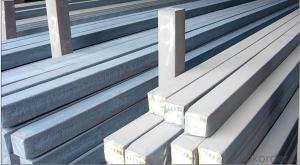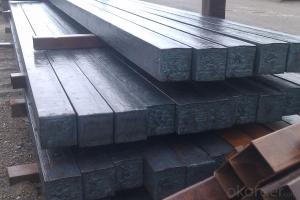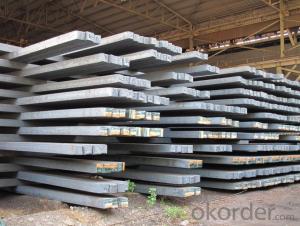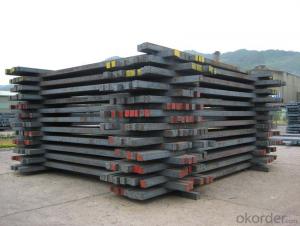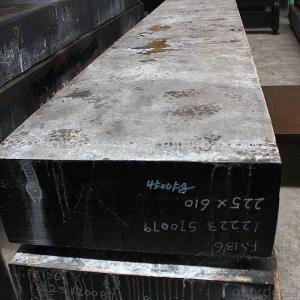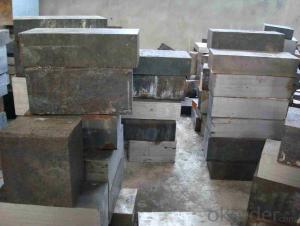Hot Rolled Steel Billet 3SP Standard 150mm
- Loading Port:
- Shanghai
- Payment Terms:
- TT OR LC
- Min Order Qty:
- 100 m.t.
- Supply Capability:
- 10000 m.t./month
OKorder Service Pledge
OKorder Financial Service
You Might Also Like
Structure of Hot Rolled Steel Billet 3SP Standard 150mm

Description of Hot Rolled Steel Billet 3SP Standard 150mm
Prepainted Rolled steel Coil is a kind of coated steel coil/sheet. With the cold rolled steel of different strength and thickness as substrate, it is produced through applying Al-Zn coat on both faces by hot dip process. In its coating, Al accounts for about 55%, Si 1.6%, while the remaining is Zn. Aluminum zinc coils enjoys both the physical protective feature and durability of Al and the electrochemical protective property of Zn. And its surface has bright silver color and regular embossed-like figure, which are highly decorative. RAL Scale Z35 Prepainted Rolled Steel Coil for Construction Roofing

Main Feature of Hot Rolled Steel Billet 3SP Standard 150mm
1.Corrosion resistance: It mainly depends on the zinc protection. When the zinc being worn,
2. Heat resistance: steel sheet has excellent heat resistance, can withstand high temperatures over 300 centigrade, and is similar with aluminized steel high temperature oxidation resistance. It often used in chimney pipes, ovens, fluorescent lighting device and the device cover.
3. Heat reflective: Galvanized steel plate heat-reflective high rate is twice as galvanized steel, often used to make insulation materials. RAL Scale Z35 Prepainted Rolled Steel Coil for Construction Roofing
Applications of Hot Rolled Steel Billet 3SP Standard 150mm
1. Construction and building: roofing; ventilating duct; handrail; partition panel;etc.
2. Electric appliance: refrigerator; washing machine; refrigerator; DVD;etc.
3.Transportation: oil tank; gas tank;road sign; etc.
4.Agriculture constructions :barn; etc.RAL Scale Z35 Prepainted Rolled Steel Coil for Construction Roofing
5.Others:vending machine; game machine; auto parts spare parts etc.
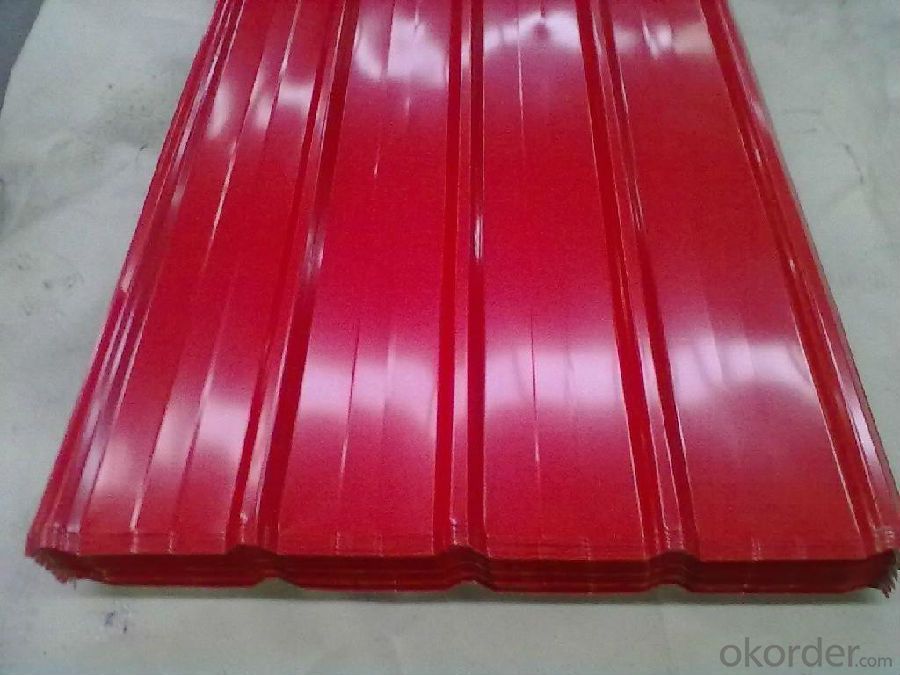
Specifications of Hot Rolled Steel Billet 3SP Standard 150mm
Product | Hot Rolled Steel Billet 3SP Standard 150mm |
Material Grade | SGCC / SGCH / DX51D+AZ, etc |
Thickness | 0.5-3.0mm |
Width | 700-1500mm |
Tolerance | Thickness: +/-0.02mm , Width:+/-2mm |
Zinc-coating | AZ30-150g/m2 |
Technique | Raw material: Hot rolled steel coil --> Cold rolled_>hot dipped galvalume |
Surface | Dried, Chromated, Unoiled,RAL Scale Z35 Prepainted Rolled Steel Coil for Construction Roofing |
Spangle | Regular spangle , small spangle, zero spangle |
ID | 508MM 610MM |
Coil weight | 25MT max |
Export package | Cardboard inner sleeves, Waterproof paper, galvanized steel covered and steel strip packed |
FAQ of Hot Rolled Steel Billet 3SP Standard 150mm
We have organized several common questions for our clients,may help you sincerely:
1. What is the minimum order quantity ?
Our MOQ is 100 mt for each size each specification. Usually we can offer discount if can buy large QTY once. RAL Scale Z35 Prepainted Rolled Steel Coil for Construction Roofing
2. How long can we receive the product after ordering?
Our general delivery time is 30 days after confirmation, but so some special orders, we have offer special delivery time
3. How to guarantee the quality of the products?
We have established the international advanced quality management system ,every link from raw material to final product we have strict quality test;We resolutely put an end to unqualified products flowing into the market. At the same time, we will provide necessary follow-up service assurance.
4. What is the payment?
We accept T/T, L/C
- Q:How are steel billets used in the production of beams and columns?
- Steel billets are an essential component in the production of beams and columns. These billets are semi-finished steel products that are typically square or rectangular in shape. They are produced through a process called casting, where liquid steel is poured into molds and allowed to solidify. Once the steel billets have solidified, they undergo further processing to transform them into beams and columns. This process involves several steps, including heating, rolling, and shaping. Firstly, the steel billets are heated to a high temperature in a furnace. This heating process is known as soaking and is carried out to make the billets more malleable and easier to shape. The billets are then passed through a series of rolling mills, where they are subjected to high pressure and shaped into their required dimensions. For beams, the steel billets are rolled into long, slender shapes with an I or H cross-section. These beams are commonly used in construction to provide structural support and load-bearing capacity. They are designed to handle heavy vertical loads and transfer them to the columns or other supporting structures. Columns, on the other hand, are produced by rolling steel billets into cylindrical shapes. These cylindrical billets are then further processed to achieve the desired diameter and length. Columns are crucial components in building construction, as they provide vertical support and help distribute the weight of the structure evenly. In summary, steel billets play a vital role in the production of beams and columns. They are transformed through heating, rolling, and shaping processes to create these structural components, which are essential for constructing sturdy and reliable buildings.
- Q:If the casting speed is not steady, what will happen to the billet?
- Secondly, the speed of cutting is unstable, and the cut rate will be reduced.
- Q:Are steel billets used in the production of sporting goods?
- Yes, steel billets are commonly used in the production of sporting goods. They are often utilized to create various components such as the shafts of golf clubs or the frames of bicycles. Steel billets provide durability and strength to these sporting goods, making them suitable for intense physical activity.
- Q:How are steel billets used in the production of flanges?
- Steel billets are an essential raw material used in the production of flanges. Flanges are critical components that connect pipes, valves, and other equipment in various industrial applications, such as oil and gas, petrochemicals, and power plants. To manufacture flanges, steel billets are first heated to a high temperature to make them malleable and easy to shape. They are then passed through a series of rolling mills, where they undergo hot rolling or forging processes. This helps to shape the steel billets into the desired flange dimensions, including outer diameter, inner diameter, and thickness. During the rolling or forging process, the steel billets are subjected to immense pressure, which helps to align the steel grains and improve the structural integrity of the flanges. This ensures that the flanges can withstand high pressures, temperature variations, and other challenging operating conditions that they may encounter during their service life. Once the initial shaping is complete, the flanges are further processed to refine their surface finish. This may involve machining, grinding, or polishing, depending on the specific requirements of the flange design. These additional processes help to achieve a smooth and precise surface, ensuring proper sealing and connection when the flanges are installed in a piping system. After the surface finish is refined, the flanges undergo various quality control checks, including dimensional inspections, mechanical testing, and non-destructive testing. These tests ensure that the flanges meet industry standards and specifications, guaranteeing their reliability and performance. In summary, steel billets are crucial in the production of flanges as they provide the raw material necessary for shaping and forming these essential components. The combination of high-temperature processing, rolling or forging, and subsequent finishing processes helps to create flanges that are strong, durable, and capable of withstanding demanding conditions in industrial applications.
- Q:How do steel billets contribute to the food processing industry?
- Steel billets contribute to the food processing industry in several ways. Firstly, steel billets are used to manufacture various machinery and equipment used in the food processing industry. For example, they are used to create conveyor belts, mixers, crushers, and packaging machines, among others. These machines play a crucial role in the processing, handling, and packaging of food products. Steel billets are also used to produce storage tanks and containers, which are essential for the safe and hygienic storage of food ingredients and finished products. These tanks are usually made of stainless steel, which is corrosion-resistant, durable, and easy to clean, ensuring that the food remains uncontaminated and of high quality. Furthermore, steel billets contribute to the construction of infrastructure in the food processing industry. They are used to build food processing plants, warehouses, and cold storage facilities. These structures provide the necessary environment for food processing, such as temperature control and proper ventilation, ensuring food safety and preservation. Additionally, steel billets are crucial for the transportation of food products. They are used to manufacture shipping containers, refrigerated trucks, and railway cars, which enable the efficient and safe transportation of food from one location to another. The strength and durability of steel ensure that the food products are protected during transit, preventing spoilage and contamination. Overall, steel billets are essential in the food processing industry as they contribute to the manufacturing of machinery, storage containers, infrastructure, and transportation systems. Their properties of strength, durability, and corrosion resistance make them ideal for ensuring food safety, quality, and efficiency in all stages of food processing.
- Q:What are the common surface defects found in steel billets?
- Common surface defects found in steel billets include: 1. Scale: Scale is a type of oxide layer that forms on the surface of steel due to exposure to high temperatures during the manufacturing process. It appears as a flaky, rough layer and can affect the quality of the steel. 2. Surface cracks: Cracks can form on the surface of steel billets due to various reasons such as improper cooling, improper handling, or excessive stress during the manufacturing process. These cracks can weaken the steel and reduce its structural integrity. 3. Inclusions: Inclusions are non-metallic impurities that can be present in the steel billet. These impurities can be in the form of oxides, sulfides, or other foreign materials. Inclusions can cause weak spots in the steel, leading to potential failures or defects in the final product. 4. Decarburization: Decarburization is the loss of carbon content from the surface of the steel billet. It occurs when the steel is exposed to high temperatures for an extended period or inadequate protective atmospheres during the manufacturing process. Decarburization can reduce the hardness and strength of the steel. 5. Surface roughness: Steel billets may have surface irregularities or roughness due to improper processing or handling. This can affect the surface finish and overall appearance of the billet. 6. Roll marks: Roll marks are impressions or patterns left on the surface of the steel billet during the rolling process. These marks can be caused by issues with the rolling mill equipment, such as improper alignment or worn-out rolls. 7. Lamination: Lamination refers to the presence of layers or separations within the steel billet. This defect can occur due to improper solidification during the casting process, inadequate temperature control, or the presence of impurities. It is important to detect and address these surface defects in steel billets to ensure the production of high-quality steel products. Various inspection techniques, such as visual inspection, ultrasonic testing, magnetic particle testing, and eddy current testing, can be used to identify and classify these defects.
- Q:What are the main characteristics of high-quality steel billets?
- The main characteristics of high-quality steel billets include a uniform and consistent composition, precise dimensions, minimal surface defects, high strength, excellent ductility, and good machinability. Additionally, they should have a smooth surface finish, low levels of impurities, and be free from cracks or internal voids. These characteristics ensure that the steel billets can be efficiently and reliably processed into various products, with superior mechanical properties and enhanced performance.
- Q:How are steel billets used in the manufacturing of gears and bearings?
- Steel billets are used in the manufacturing of gears and bearings as they serve as the raw material for forging or casting processes. These billets are heated and shaped into the desired form, such as gear blanks or bearing races, using specialized machinery. The high strength and durability of steel make it an ideal material choice for these applications, ensuring the gears and bearings can withstand heavy loads and provide smooth operation.
- Q:Can steel billets be forged?
- Yes, steel billets can be forged.
- Q:How do steel billets contribute to the construction industry?
- Steel billets contribute to the construction industry by serving as the raw material for various steel products used in construction. These billets are transformed into beams, columns, rods, and other structural components that provide strength, stability, and durability to buildings and infrastructure. Additionally, steel billets are used in the manufacturing of reinforcements for concrete, enhancing the structural integrity of concrete structures such as bridges, highways, and buildings. Overall, steel billets play a crucial role in the construction industry by providing the necessary materials for safe and reliable structures.
1. Manufacturer Overview |
|
|---|---|
| Location | |
| Year Established | |
| Annual Output Value | |
| Main Markets | |
| Company Certifications | |
2. Manufacturer Certificates |
|
|---|---|
| a) Certification Name | |
| Range | |
| Reference | |
| Validity Period | |
3. Manufacturer Capability |
|
|---|---|
| a)Trade Capacity | |
| Nearest Port | |
| Export Percentage | |
| No.of Employees in Trade Department | |
| Language Spoken: | |
| b)Factory Information | |
| Factory Size: | |
| No. of Production Lines | |
| Contract Manufacturing | |
| Product Price Range | |
Send your message to us
Hot Rolled Steel Billet 3SP Standard 150mm
- Loading Port:
- Shanghai
- Payment Terms:
- TT OR LC
- Min Order Qty:
- 100 m.t.
- Supply Capability:
- 10000 m.t./month
OKorder Service Pledge
OKorder Financial Service
Similar products
New products
Hot products
Related keywords
